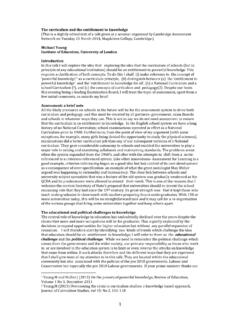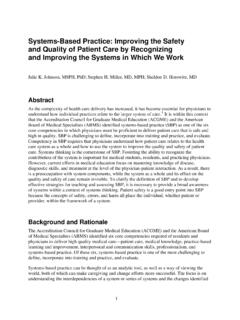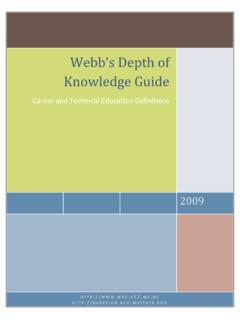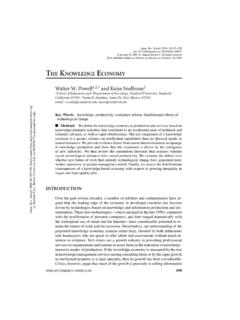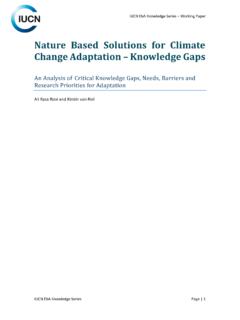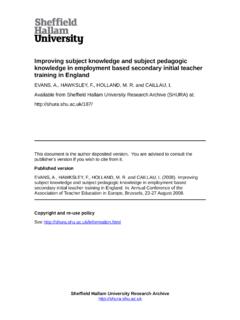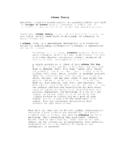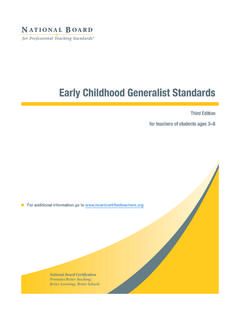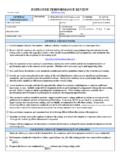Transcription of Knowledge-Based Systems: Concepts, Techniques, Examples
1 Knowledge-Based Systems Concepts, Techniques, Examples Reid G. Smith Schlumberger-Doll Research Old Quarry Road Ridgefield, CT USA 06877 Presented at the Canadian High Technology Show. Lansdowne Park, Ottawa, ON, May 8, 1985. This course will discuss the key concepts and techniques behind the Knowledge-Based Systems that are the focus of such wide interest today. These systems are at the applied edge of research in Artificial Intelligence. To put them in perspective this course will take a short historical tour through the AI field and its related subtopics. This tour will focus on underlying themes, with Examples drawn from representative systems.
2 The key factors that underly Knowledge-Based systems are knowledge acquisition, knowledge representation, and the application of large bodies of knowledge to the particular problem domain in which the Knowledge-Based system operates. Dr. Smith will discuss a number of formalisms for knowledge representation and inference that have been developed to aid in this process. Once again, this will be illustrated with Examples drawn from existing systems. The course will conclude with a discussion of the pragmatics of actually building a Knowledge-Based system. This will include: (1) suggestions for selecting problems that are amenable to the Knowledge-Based system approach, and (2) a description of the characteristics of software tools and high-level programming environments that are useful, and for most purposes necessary, for the construction of a practical Knowledge-Based system.
3 Reid G. Smith is the program leader for Expert Geology Systems at Schlumberger-Doll Research, Ridgefield, Connecticut, where he has been since 1982. His current research is on expert systems which explain failures and develop justifications for the information in their knowledge bases. He has been involved in the Dipmeter Advisor project and in the development of tools for expert system construction. He has also worked in Knowledge-Based systems for passive sonar interpretation for the Canadian Defense Research Establishment Atlantic. Dr. Smith received his B. Eng. and M. Eng. in electrical engineering at Carleton University before doing a at Stanford.
4 He is the author of A Framework for Distributed Problem Solving (UMI Press). 2 PROSPECTUS Artificial Intelligence Underlying Themes Knowledge-Based Systems Underlying Themes Example: MYCIN Example: DIPMETER ADVISOR Assessment and Outlook <break> Representation and Reasoning Rules / Chaining Structured Objects / Inheritance Procedural Attachment Pragmatics Perspective 3 Artificial Intelligence Goals: To construct computer programs that perform at high levels of competence in cognitive tasks Knowledge-Based Systems To understand and develop computational models of human intelligence Cognitive Science As Experimental Computer Science.
5 Side Effects Time-sharing Sophisticated Programming Environments Exploratory Programming Personal Machines Local Area Network Processing FOUR AREAS OF COMPUTING Type of Information NUMERIC SYMBOLIC Type of Processing ALGORITHMIC traditional scientific calculations data processing HEURISTIC computation- intensive application with heuristic control (manipulators) Artificial Intelligence 4 5 WHAT IS A Knowledge-Based SYSTEM? Symbolic: It incorporates knowledge that is symbolic [as well as numeric]. Heuristic: It reasons with judgmental, imprecise, and qualitative knowledge as well as with formal knowledge of established theories.
6 Transparent: Its knowledge is simply and explicitly represented in terms familiar to specialists, and is separate from its inference procedures. It provides explanations of its line of reasoning and answers to queries about its knowledge . Flexible: It is incrementally refinable and extensible. More details can be specified to refine its performance; more concepts and links among concepts can be specified to broaden its range of applicability. It is an expert system if it provides expert-level solutions. The power lies in task-specific knowledge . Generality and Power Power Generality AI Paradigm Shift: circa 1970-72 6 7 SOME BASIC PRESCRIPTIONS Don t tell the program what to do, tell it what to know.
7 Keep the knowledge in the knowledge base. Choose a representation that is as high-level transparent as possible. The task is elucidating and debugging knowledge , not writing and debugging a program.. knowledge Programming Basic Knowledge-Based System Architecture Major Architectural Lesson 8 9 EXAMPLE: MYCIN MAIN ISSUES IN THE knowledge LIES THE POWER HOW TO DEAL WITH INCOMPLETE, INEXACT DATA HOW TO DEAL WITH INEXACT INFERENCE THE UTILITY AND POWER OF SIMPLE MECHANISMS THE IMPORTANCE OF SYSTEMS THAT ACCOMMODATE THE USER 10 --------PATIENT-248-------- 1) Patient's name: (first-last) ** 2) Sex: ** MALE 3) Age: ** 52 4) Have you been able to obtain positive microbiological information about a possible infection of ** YES --------INFECTION-1-------- 5) What is the infection?
8 ** ENDARTERITIS 11 The first significant organism from this blood culture (CULTURE-1) will be referred to as: --------ORGANISM-1-------- 9) Enter the identity of ORGANISM-1: ** UNKNOWN 10) Is ORGANISM-1 a rod or coccus (etc.)?: ** ROD 11) The gram stain of ORGANISM-1: ** GRAMNEG 12) Have there been POSITIVE cultures yielding organisms about which you will NOT be seeking advice? ** YES 12 14) Is the patient's illness with ORGANISM-1 a hospital-acquired infection? ** WHY [ , WHY is it important to determine whether or not the infection with ORGANISM-1 was acquired while the patient was hospitalized?] [ ] This will aid in determining the identity of ORGANISM-1.
9 It has already been established that [ ] the morphology of ORGANISM-1 is rod [ ] the gram stain of ORGANISM-1 is gramneg [ ] the aerobicity of ORGANISM-1 is facul Therefore, if [ ] the infection with ORGANISM-1 was acquired while the patient was hospitalized then there is weakly suggestive evidence (.2) that the identity of ORGANISM-1 is pseudomonas [RULE050] 13 15) Enter the identity of ORGANISM-2: ** SALMONELLA (.4) (.3) 14 INFECTION-1 is ENDARTERITIS with BACTEREMIA <item 1> [ORGANISM-1] <item 2> SALMONELLA (species unknown) [ORGANISM-1] <item 3> KLEBSIELLA-PNEUMONIAE [ORGANISM-1] <item 4> PSEUDOMONAS-AERUGINOSA [ORGANISM-1] <item 5> ENTEROBACTER [ORGANISM-1] <item 6> PROTEUS-NON-MIRABILIS [ORGANISM-1] 15 [Rec 1 ] My preferred therapy recommendation is as follows: In order to cover for Items <1 3 4 5 6>: Give: GENTAMICIN Dose: 128 mg ( ) q8h IV (or IM) for 10 days Comments: Modify dose in renal failure In order to cover for Item <2>.
10 Give: CHLORAMPHENICOL Dose: 563 mg ( mg/kg) q6h for 14 days Comments: Monitor patient's white count Do you wish to see the next choice therapy? ** NO 16 Rule 27: If 1) the gram stain of the organism is gram negative, and 2) the morphology of the organism is rod, and 3) the aerobicity of the organism is anaerobic, Then: There is suggestive evidence (7) that the identity of the organism is Bacteroides 17 INEXACT INFERENCE DESIDERATA COMMUTATIVE ASYMPTOTIC BALANCING OF + AND EVIDENCE CF range: {-1 .. 0 .. 1} {} = pppnpppppCF + CF(1 - CF )CF , CF > 0CF CF + CF(1 + CF )CF , CF < 0(CF + CF) / (1 - min CF , CF ) pCF CF < 0 18 19 ** WHAT WAS THE IDENTITY OF ORGAISM-1 ?
